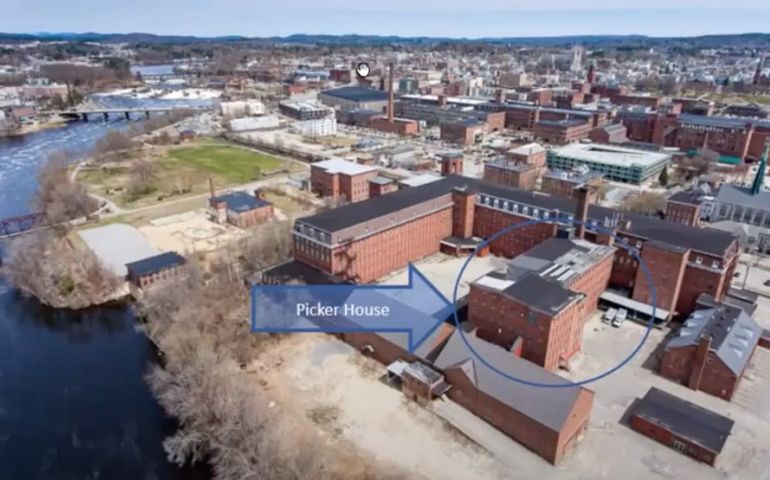
Lewiston council approves TIF for housing proposal in part of Continental Mill
 Screenshot / Szanton Co.
Picker House Lofts at the Continental Mill complex in Lewiston is proposed as a mixed-income housing project.
Screenshot / Szanton Co.
Picker House Lofts at the Continental Mill complex in Lewiston is proposed as a mixed-income housing project.
A proposal is in the works to convert a portion of the Continental Mill in Lewiston into a 72-unit, mixed-income housing development.
To help get the project underway, the Lewiston City Council on Tuesday approved a tax increment financing district that would allow the developer to use a portion of the property tax to service project debt.
Szanton Co. of Portland is seeking to develop the project, which is dubbed Picker House Lofts and has an address of 2 Cedar St. The proposal centers on a 79,000-square-foot, L-shaped building that’s just one portion of the much larger 560,000-square-foot Continental Mill complex.
The development would create 46 units of workforce housing and 26 units of market-rate housing comprised of a mix of one-, two- and three-bedroom units.
$16.8M development
The current value of the building is $88,789, which yields $2,546 in annual property tax paid to the city.
Development costs for the project are estimated to be a minimum of $16.8 million. The renovation would increase the value of the property to $4.1 million, which would yield $117,547 in annual tax paid to the city.

To be financially viable, Szanton is seeking a mix of public and private financing. That includes the TIF agreement and an allocation of federal low-income housing tax credits from MaineHousing.
The TIF, as approved by the council, will create a 23-year agreement.
During years 1-3, no funds will be returned to the developer. Once the project is operational and the property has reached its optimal value, 75% of “captured revenue” — or the new tax generated by the project — will be returned to the developer each year for a decade.
After that, the percentage of capture will decrease by 3% each year until the district’s term ends in year 23.
Over that timeframe, $1.5 million will flow back to Szanton and the city will net $870,000.
The agreement applies only to the new tax generated by the project, or about $115,000.
$1M funding gap
Amy Cullen, a vice president and project manager with Szanton, told the council that the TIF agreement is needed to cover a funding gap of $1 million. The gap is largely driven by rising construction costs, she said.
The tax funds that will be returned to Szanton, as a result of the TIF agreement, will help pay off the additional mortgage incurred to fill the $1 million gap, said the company’s president, Nathan Szanton.
“Sometimes members of the public think it goes into the developer’s pocket,” Szanton said. “Nothing could be further from the truth, at least in our projects. It all goes toward filling the gap between the cost of building the project and the sources that we have to be able to build it.”
The TIF is also expected to help Szanton obtain a low-income housing tax credit through MaineHousing.
Exciting property
Szanton Co., a real estate development firm, specializes in developing mixed-income rental housing in or near downtowns in Maine and New Hampshire.
Picker House Lofts would be Szanton’s third housing development in Lewiston. The other two are the 48-unit Lofts at Bates Mill, which opened in 2012, and the mixed-use Hartley Block on Lisbon Street, a new construction that has 63 units and opened in 2019.
“We would love to be part of bringing alive the Continental Mill,” said Szanton. “It’s such an exciting property.”

Szanton cited proximity to Lewiston’s downtown and its location on Riverfront Island as top features of the mill.
Riverfront Island is considered a pivotal area within the city’s downtown riverfront. At the nearby Bates Mill Complex, high-quality restoration has attracted offices, destination restaurants, a brewery, a medical space, and new loft-style housing. New cultural destinations and outdoor spaces have also been springing up through the Riverfront Island area.
At Continental Mill, the main structure forms a square with two interior courtyards. A handful of other buildings surround it. It was built in 1858 to produce cotton.
Szanton said he had tried for some years without success to purchase the 79,000-square-foot building, which is in the center of the Continental Mill complex.
But the longtime family owner at the time wasn’t interested in selling just part of the complex, Szanton said.
In 2019, the complex was acquired at auction by Eric Chinburg, president of Chinburg Properties in Newmarket, N.H. Chinburg agreed to sell the 79,000-square-foot building to Szanton.
Workforce rents
Rent for the workforce units is expected to range from $762 to $1,047 for individuals earning up to $42,000, which is 60% of area median income. For folks earning up to $35,000, which is 50% of area median income, rents are expected to range from $629 to $862.
Rent for the market-rate units is expected to be $975 for one-bedrooms; rent for three-bedrooms hasn’t been calculated yet.
Rent will include heat, hot water, Wi-Fi, fitness room, indoor bike storage, a resident service coordinator on-site, and parking, Cullen said.
The company submitted a site plan to Lewiston’s planning department in May and hopes to have city approvals completed by August, at which time it will submit its tax credit application to MaineHousing.
Assuming the application goes through, it’s expected project design could be completed by spring 2022, with construction to start that summer. Construction could be completed by fall 2023, with the first tenants moving in at that time.
“I just want to express my enthusiasm for this project,” said Councilor Alicia Rea.
Rea said the mixed-income feature is important to the community, where housing affordable at all levels of income is needed.
In the sole vote against the TIF, though, Councilor Luke Jensen said he didn’t support the district for non-market-rate housing specifically on Riverfront Island. The city’s focus for the island, he said, should be on market-rate housing for income-earners who can afford to patronize the “niche” restaurants and businesses that the city envisions there.
“I support Szanton Co. and everything they’ve done in Lewiston, but I don’t see this fitting in well with the city’s vision,” he said.
Mayor Mark Cayer said that, at one time, he had the same concerns. But there are other opportunities for market-rate housing in that area, including development elsewhere in the Continental Mill complex, he said.
“Don’t people making $40,000 per year deserve a place to live and be part of the community?” said Cayer. “This isn’t subsidized housing. It’s truly people who work hard every day.”
Among other recent projects, Szanton is also proposing a $12.5 million, 49-unit apartment building in the developing Cape Elizabeth town center, which would be the first below-market apartments built in the town since the 1970s.
And it has the final piece in place to begin work on a 50-apartment project on the site of the former YMCA in downtown Bath.













0 Comments